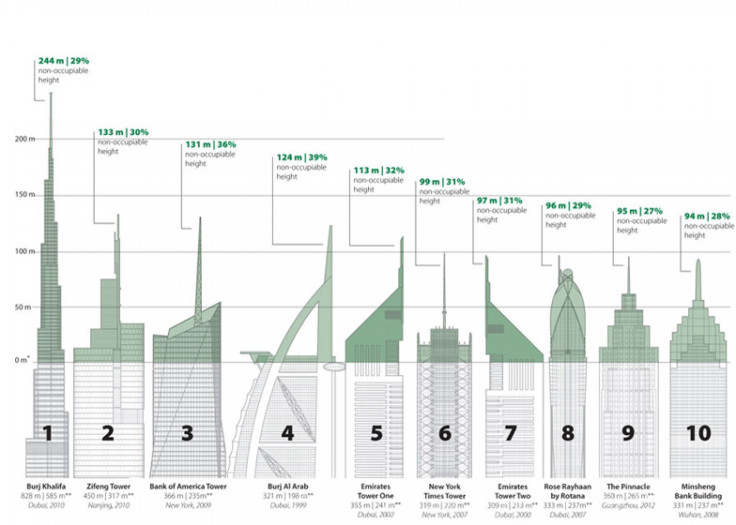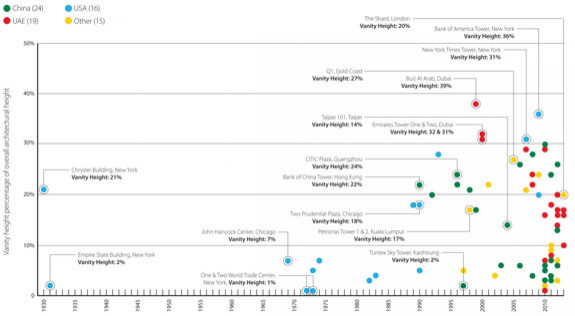Council On Tall Buildings Creates New Term ‘Vanity Height’ To Describe Useless Space In Today’s Skyscrapers

The Council on Tall Buildings and Urban Habitat, or CTBUH, noted in a report this week that it had noticed an unusual trend in the construction of “supertall” skyscrapers, or those over 300 meters (985 feet): “vanity height.” And nowhere is vanity height more en vogue, it said, than the glitzy emirate of Dubai, which boasts an estimated 19 percent useless space total across its skyline.
“We noticed in … Kingdom Tower, Jeddah, [which is set to become the world’s next tallest building if it opens as planned in 2017] that a fair amount of the top of the building seemed to be an unoccupied spire,” CTBUH noted. “This prompted us to investigate the increasing trend towards extreme spires and other extensions of tall buildings that do not enclose usable space, and create a new term to describe this -- Vanity Height, i.e., the distance between a skyscraper’s highest occupiable floor and its architectural top, as determined by CTBUH Height Criteria.”
Thus, the organization compiled a list of the world’s 10 “vainest” skyscrapers, five of which poke at the clouds above Dubai. With a vanity height of nearly 124 meters (405 feet) within the overall architectural height of 321 meters (1,055 feet), Dubai’s Burj Al Arab was found to be the “vainest” of them all. The luxury hotel has the highest non-occupiable-to-occupiable height ratio of the supertalls at 39 percent.
The nearby Burj Khalifa, the world’s tallest building, boasts a vanity height of 244 meters (800 feet), or about 29 percent. If that unused height were to be a stand-alone skyscraper in Europe, CTBUH said it would be the continent’s eleventh tallest building.
Yet, Dubai is not alone in the vanity department. Three of the top 10 buildings for vanity height lie in China (the Zifeng Tower, the Minsheng Bank Building and The Pinnacle), while two reside in New York (the Bank of America Tower and the New York Times Tower). New York is set to gain a third spot on the list with the completion of the spire-topped One World Trade Center in 2014.
CTBUH said that without vanity height, 61 percent of the world’s tallest buildings (or 44 out of the 72 supertall buildings) would lose their supertall status. Any structure, telecommunications towers included, with more than 50 percent vanity height is deemed a non-building under CTBUH criteria.
The organization charted the rise of vanity height over the last century and found that the trend began with New York’s Chrysler Building in 1930, but it did not kick off until the mid-1990s. The concept exploded around 2010, thanks in no small part to the rise of China and the United Arab Emirates. Both nations have used their supertall buildings (with altitude-enhancing designs) to spur economic development and boost their reputations on the global stage.

© Copyright IBTimes 2024. All rights reserved.






















